|
|
Canku Ota |
|
|
(Many Paths) |
||
|
An Online Newsletter Celebrating Native America |
||
|
September 20, 2003 - Issue 96 |
||
|
|
||
|
The Lazy Rabbit |
||
|
An Anishanabe Legend |
||
|
And
no matter how much she scolded him, Ableegumooch refused to mend
his ways. Glooscap,
far away in his lodge on Blomidon, saw that the rabbit was becoming
a thoroughly useless creature. He must be warned against the dangers
of laziness. So, wasting no time, Glooscap descended from his
lodge to the beach in three huge strides, launched his canoe,
and paddled across the Bay of Fundy to the shore near the rabbit's
home.
It's
a lovely day to do He paid no attention to the tasty leaves and berries he might have been gathering for dinner. He was much more interested in watching other people work.
"Ableegumooch,
be careful!" The
rabbit jumped and whirled about, but there was nobody there. The
voice spoke again, from somewhere over his head. "Take
care, Ableegumooch, or your lazy ways will bring you pain and sorrow."
The
rabbit looked up and saw the fir tree shake like a leaf in a storm,
yet not a breath of wind stirred. Frightened out of his wits, he
ran--and he never stopped running until he was safe at home, where
he told his grandmother what had happened. "Glooscap
has given you a warning," said his grand mother. "Be sure
to obey him, grandson, or you will be sorry."
It's
a lovely day to do So
sang Ableegumooch as he sauntered through the glory of autumn trees.
Noogumee begged and scolded and pleaded, but he continued to spend
more time visiting his neighbours than gathering food. One day,
when winter had come to the land, he came to the wigwam of Keoonik
the Otter. Keoonik politely asked him to dine, and the rabbit promptly
accepted. Keoonik turned to his elderly house keeper and addressed
her in the usual Indian fashion: "Noogumee,
prepare the meal." Then he took some fishhooks and went off, the rabbit hopping along behind, curious to see what he was going to do.
"Gracious!"
thought Ableegumooch. "If that isn't an easy way to get a living.
I can do that as well as Keoonik," and he invited the otter
to be his guest at dinner on the following day. Then he hurried
home. "Come,"
he said to his grandmother, "we are going to move our lodge
down to the river." And in spite of all she could say, he insisted
on moving it. Noogumee reminded him that the wigwam was empty of
food, and he ought to be out hunting, but Ableegumooch paid no attention.
He was busy making a slide like Keoonik's. The weather was cold,
so all he had to do was pour water down the snowy bank, where it
soon froze, and there was his fishing slide. Early next day, the
guest arrived. When it was time for dinner, Ableegumooch said to
his grandmother: "Noogumee,
prepare the meal." "There
is nothing to prepare," said she, sadly. "Oh,
I will see to that," said the rabbit with a confident laugh,
and he took his place at the top of the slide to go fishing. When
he tried to push off, however, he found it was not so easy. His
coat was rough and bulky and dry, not smooth and slippery like the
otter's. He had to wriggle and push with his heels until at last
he slid down and plunged into the water. The cold took his breath
quite away, and he suddenly remembered he was unable to swim. Struggling
and squealing, he thought no more of fishing, for he was in great
danger of drowning. "What
on earth is the matter with him?" Keoonik asked the grandmother.
"I
suppose he has seen someone else do that," sighed Noogumee,
"and he thinks he can do it too." Keoonik
helped the freezing, half-drowned rabbit out of the water and, since
there was nothing to eat, went home hungry and disgusted. But
do you think that cold bath cured Ableegumooch? Not at all. The
very next day, as he ran idly through the forest, he came to the
lodge of some female woodpeckers. He was delighted when these Antawaas
invited him to dinner. He
watched eagerly to see how they found food.
"My,
oh my!" thought Ableegumooch. "How easily some people
get a living. What is to prevent me from getting mine in that fashion?"
And he told the Antawaas they must come and dine with him. On
the day following, they appeared at the rabbit's lodge and Ableegumooch
said to his grandmother importantly: "Noogumee,
prepare the meal." "You
foolish rabbit," said she, "there is nothing to prepare."
"Make
the fire," said the rabbit grandly, "and I shall see to
the rest." He
took the stone point from an eel spear and fastened it on his head
in imitation of a woodpecker's bill, then climbed a tree and began
knocking his head against it. Soon his head was bruised and bleeding,
and he lost his hold and fell to the earth with a tremendous crash.
The Antawaas could not keep from laughing. "Pray
what was he doing up there?" "I suppose he has seen someone else do that," said Noogumee, shaking her head, "and thinks he can do it too." And
she advised them to go home, as there would be no food for them
there that day.
"This
must be the easiest way of all to get a dinner," marvelled
Ableegumooch, and he invited Mooin to dine with him next day. Now
what the rabbit did not know was that the bears preserve food on
their feet. They press ripe blueberries with their paws and, after
the cakes have dried upon them, cut bits off to eat. The silly rabbit
thought Mooin had actually cut pieces off his paws! At
the appointed time, Ableegumooch ordered his grand mother to prepare
the meal, and when she said there was nothing to prepare, he told
her to put the kettle on and he would do the rest. Then he took
a stone knife and began to cut at his feet as he had seen Mooin
do. But oh dear me, it hurt. It hurt dreadfully! With tears streaming
down his cheeks, he hacked and hacked, first at one foot and then
at the other. Mooin the Bear was greatly astonished. "What
on earth is the fellow trying to do?" he asked. Noogumee
shook her head dismally. "It
is the same old thing. He has seen someone else do this."
Then
at last, Ableegumooch, nursing his sore feet, remembered what Glooscap
had said. All at once, he saw how silly he had been. "Oh
dear!" he said. "My own ways of getting food are hard,
but others' are harder. I shall stick to my own in the future,"
and he did. From
then on, the wigwam of Ableegumooch and his grandmother was always
well stored with food, winter and summer, and though he still sings,
his song has changed: It's
a wiser thing to be Print and Color Your Own Blue Jay Picture |
|
|

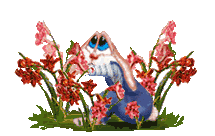 In
the Old Time, as you know, Ableegumooch was Glooscap's forest
guide and helped wayfarers lost in the forest. However, as time
went on, Indians and animals learned to find their own way through
the trees and did not need the rabbit's services so often. Ableegumooch
grew fat and lazy. If there was something easy and pleasant to
do, he did it. If the thing were difficult or tiring, he did not.
Now that is no way to keep a wigwam stocked with food. Often,
poor old Noogumee, his grandmother, with whom he lived, had to
hunt for food herself, or they would have gone hungry.
In
the Old Time, as you know, Ableegumooch was Glooscap's forest
guide and helped wayfarers lost in the forest. However, as time
went on, Indians and animals learned to find their own way through
the trees and did not need the rabbit's services so often. Ableegumooch
grew fat and lazy. If there was something easy and pleasant to
do, he did it. If the thing were difficult or tiring, he did not.
Now that is no way to keep a wigwam stocked with food. Often,
poor old Noogumee, his grandmother, with whom he lived, had to
hunt for food herself, or they would have gone hungry.  It
was a fine bright morning, the air cool and tasting of salt, as
it always does in the Maritime Provinces. And presently along
hopped the rabbit, singing with fine spirit:
It
was a fine bright morning, the air cool and tasting of salt, as
it always does in the Maritime Provinces. And presently along
hopped the rabbit, singing with fine spirit: 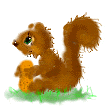 There
was Miko the Squirrel scampering up the big maple tree, his cheeks
bulged out with nuts, pausing only long enough to scold Ableegumooch
for coming too near his storehouse.There
was Mechipchamooech the Bumble Bee, busy at the golden rod, gathering
honey for his hive. And there was Teetees the Blue Jay, flying worms
to his family in the big pine. It was all so interesting that Ableegumooch
stopped beside a stately fir tree to enjoy the scene. Suddenly behind
him, he heard a voice.
There
was Miko the Squirrel scampering up the big maple tree, his cheeks
bulged out with nuts, pausing only long enough to scold Ableegumooch
for coming too near his storehouse.There
was Mechipchamooech the Bumble Bee, busy at the golden rod, gathering
honey for his hive. And there was Teetees the Blue Jay, flying worms
to his family in the big pine. It was all so interesting that Ableegumooch
stopped beside a stately fir tree to enjoy the scene. Suddenly behind
him, he heard a voice.  The
rabbit's legs were still trembling from fright and exertion, and
he promised at once that he would take care to mend his lazy ways
in future. And indeed, for a while, he went busily about his hunting
and kept the wigwam well stocked with food. But, when autumn came,
he grew lazy again and went back to his old careless ways.
The
rabbit's legs were still trembling from fright and exertion, and
he promised at once that he would take care to mend his lazy ways
in future. And indeed, for a while, he went busily about his hunting
and kept the wigwam well stocked with food. But, when autumn came,
he grew lazy again and went back to his old careless ways.  Keoonik
sat on the snowy bank of the river and slid down an icy path into
the water. In a moment, he reappeared with a string of eels which
he carried to his grandmother, and she promptly cooked them for
dinner.
Keoonik
sat on the snowy bank of the river and slid down an icy path into
the water. In a moment, he reappeared with a string of eels which
he carried to his grandmother, and she promptly cooked them for
dinner.  One
of the woodpeckers took a dish, went up the side of an old beech
tree and quickly dug out a plentiful supply of food, which was cooked
and placed before the rabbit.
One
of the woodpeckers took a dish, went up the side of an old beech
tree and quickly dug out a plentiful supply of food, which was cooked
and placed before the rabbit. 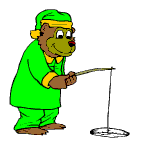 Now,
sore as he was, you would certainly think the rabbit had learned
his lesson. Yet, a day or two later, he was idling in the woods
as usual when he came upon Mooin the Bear, who invited him to dinner.
He was greatly impressed at the way in which the bear got his meal.
Mooin merely took a sharp knife and cut small pieces off the soles
of his feet. These he placed in a kettle on the fire, and in a short
while they enjoyed a delicious meal.
Now,
sore as he was, you would certainly think the rabbit had learned
his lesson. Yet, a day or two later, he was idling in the woods
as usual when he came upon Mooin the Bear, who invited him to dinner.
He was greatly impressed at the way in which the bear got his meal.
Mooin merely took a sharp knife and cut small pieces off the soles
of his feet. These he placed in a kettle on the fire, and in a short
while they enjoyed a delicious meal. 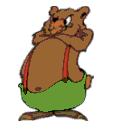 "Well!"
said Mooin crossly, "It is most insulting to be asked to dinner
and get nothing to eat. The trouble with that fellow is-- he's lazy!"
and he went home in a huff.
"Well!"
said Mooin crossly, "It is most insulting to be asked to dinner
and get nothing to eat. The trouble with that fellow is-- he's lazy!"
and he went home in a huff.  Cool
fact: Infamous as a destroyer of eggs and nestlings, Blue Jays actually
derive only a small percentage of their annual food needs from these sources.
Its diet is mostly vegetarian, including especially acorns, beech nuts,
and seeds. Blue Jays also eat a variety of animal foods including grasshoppers,
beetles, caterpillars, and small vertebrates. Blue Jays are intelligent
and adaptable, taking advantage of almost any food resource, and will
readily take to back yard bird feeders. Nonmigratory populations of Blue
Jays store food such as acorns in bark crevices or in the soil.
Cool
fact: Infamous as a destroyer of eggs and nestlings, Blue Jays actually
derive only a small percentage of their annual food needs from these sources.
Its diet is mostly vegetarian, including especially acorns, beech nuts,
and seeds. Blue Jays also eat a variety of animal foods including grasshoppers,
beetles, caterpillars, and small vertebrates. Blue Jays are intelligent
and adaptable, taking advantage of almost any food resource, and will
readily take to back yard bird feeders. Nonmigratory populations of Blue
Jays store food such as acorns in bark crevices or in the soil. 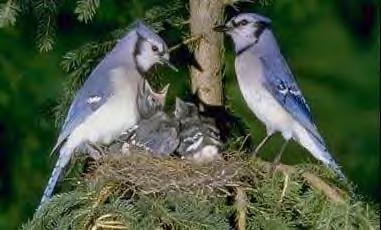 When
around the nest, Blue Jays become more quiet. The nest is usually situated
between 8 and 20 feet up in a coniferous, or occasionally, deciduous tree.
The nests of other passerines are sometimes appropriated by these jays.
The female incubates most of the eggs, and she may be fed by the male
while on her nest. Both parents bring food for the hatchlings. In late
summer and fall, Blue Jays travel in small flocks and family groups.
When
around the nest, Blue Jays become more quiet. The nest is usually situated
between 8 and 20 feet up in a coniferous, or occasionally, deciduous tree.
The nests of other passerines are sometimes appropriated by these jays.
The female incubates most of the eggs, and she may be fed by the male
while on her nest. Both parents bring food for the hatchlings. In late
summer and fall, Blue Jays travel in small flocks and family groups.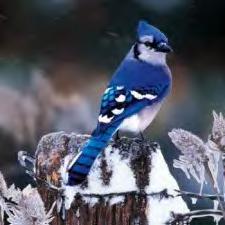 Description:
Blue Jays are medium-sized (approximately 11 inches in length), colorful
birds with crests. Their crown and crest are light violet-blue. Under
the base of the crest and extending through the eyes across the forehead
is a black band. Over the eye is a short white superciliary stripe; ear
coverts, cheek, and throat are also white. Below the throat is a narrow
black necklace that extends upward and connects behind the ear-coverts
with the black head band. The lower breast, belly, and vent area are off-white.
Description:
Blue Jays are medium-sized (approximately 11 inches in length), colorful
birds with crests. Their crown and crest are light violet-blue. Under
the base of the crest and extending through the eyes across the forehead
is a black band. Over the eye is a short white superciliary stripe; ear
coverts, cheek, and throat are also white. Below the throat is a narrow
black necklace that extends upward and connects behind the ear-coverts
with the black head band. The lower breast, belly, and vent area are off-white.